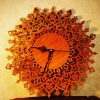You need to start somewhere and these few tools will take you a long way. Always buy the best you can.

| 23 August 2021 06:50
Thank you for explaining the details Chris. The D tools do feel a little too small, so I will get them changed.
Just wanted to also take this opportunity to thank you for the great videos and teachings! Super thrilled to have found this course! Thanks

| 20 August 2021 18:33
Leyli - I believe the D series are what Pfeil are calling 'medium sized'. The thing is, hands come in many different sizes.Those with smaller hands find large handles and longer tools quite awkward to use. There is no rule for carving tool handles or lengths and several firms make tools in larger ('standard') sizes to give carvers an option.
The sweep and width is fixed though, no matter what, and the steel and tempering of all tool will be the same.
So the only question is how the tools feel when you hold them and imagine using them? I have tools of many different lengths and handle shapes and love the all.
However:
If the D tools feel comfortable in your hands then you can happily go ahead and carve with them. If they feel small, you should swap them out for the larger size, those without the D prefix. Or perhaps you'd prefer all D tools? It's all down to how they feel. Tools are, after all, only a means to an end: your carving.
Hope this helps!

| 18 August 2021 10:52
Hi, I have just received the tools that I had ordered and Two of them look smaller in length. so the sweep and width seem right but the actual tool itself is smaller. Two of them are about 24 cm long (Pfeil chisel 1S and Pfeil v Tool 60) and Two are 18.5 cm long with slightly narrower handles (Pfeil D7 14mm and Pfeil Gouge D2 12 mm)). Have I made a mistake in the order? Are these ok to use or should I return the smaller ones? Sorry if this is a silly question, I am a total beginner and found the purchase of the tools really hard.

| 27 March 2021 17:32
Shawn - Sometimes you need an exact tool, for example mouldings or lettering. However, with most other carving you can use several tools to do the same job - as here.
I would get what you can, bigger rather than smaller, and see how you get on. Then in your future work from what you have to what you find you need.

| 05 August 2020 18:14
Miroslav - I think a straight V tool is the best for most work, the curved one is used for recesses such as inside bowls. I suggest you use the V tool you have for now and see how you get on.
Both curved and straight V tools are sharpened in the same way.

| 04 August 2020 16:45
Hi, my V gouge is curved, is it ok? Or should I buy flat one? Thanks for respond.

| 14 January 2020 18:59
Chris - All woodcarving chisels and skew chisels have uniform bevels on both sides of a symmetrical blade. So, yes, double bevel.

| 14 January 2020 04:38
Is the Pfeil skew chisel mentioned single or double bevel?

| 05 April 2019 12:20
Thanks Chris, that's a very clear explanation. So in a way it's perhaps more surprising - given the comparative fragility of the tips of fishtails in smaller sizes - that they too don't have that little bit of springiness in the shaft.

| 05 April 2019 11:31
Joe - The blade of a carving tool is tempered for hardness; however, with this comes a degree of brittleness - you can break the edge by levering it. The shank of a carving tool, between blade proper and shoulder at the handle should be tempered less for hardness and more for resilience. Thus it's a bit springy and will absorb levering and mallet work. You can still snap it but not in normal use.
Now, a regular gouge with parallel sides has a short shank and you hardly notice any difference whereas you will notice this difference in a fishtail which, or course has a very long shank and may feel a little springy.
To be clear: this hardness/resilience balance is desirable. I like a slight springiness, but only slight, which give the tool a different feel.
Different manufacturer's balance these qualities in different ways and it should never be a problem. The best this is to find a make of gouge you like the feel of and stick with it.
I hope this explains it!

| 05 April 2019 09:19
Hi Chris. I'm curious about the importance of flexural stiffness of the smaller gouges.
I now have a small Auriou fishtail (I couldn't resist!) which, counterintuitively for such a small thing, is considerably stiffer than the Auriou #6 5mm straight of approx the same size (the shaft is much thicker throughout although it's obviously also narrower). Same applies for the #9 I picked up. So I did some research and it appears all the #6 approx 1/4" straight/allongee gouges across all brands have really thin (2mm thick) shafts with a lot of flex. The fishtails of all brands around the same size, meanwhile, are very stiff. Is this deliberate? I'd expected the goal would always be maximum stiffness for better guidance - and maybe even allow very light mallet taps.
Thanks again.

| 26 March 2019 08:13
Jof - Fishtail gouges wear quickly compared to the common-or-garden, parallel-sided gouge, becoming narrower as they get shorter of course - so less bang for your buck than you'd think. I have well-used regular gouges 120 years old, still good for a lot more, but no fishtails that age unless they've hardly been used. Fishtails are also more delicate tools anyway, particularly those where corners are more prominent, so more vulnerable to damaging.
So, for sculptural and bigger carving, it's best to do the harder, rougher work with regular gouges and then switch to the fishtails for finishing and delicate work.
Having said that, there's nothing to stop you working full time with fishtails if that's what you'd like to do!

| 24 March 2019 20:05
Hi Chris. I've been swatting up on your videos and there's one thing I'd love an answer to that's only covered very briefly elsewhere.
Fishtail gouges appear to offer advantages over straight and allongee yet I don't see them used for in the round sculpting anywhere - here or elsewhere online. But I wonder: for relatively detailed work (e.g. for 6-14mm tools) is there any reason why I shouldn't use short-profile fishtail gouges (like the Auriou) for everything? It seems I could get more bang for my buck this way with fewer do-it-all tools :)

| 07 October 2017 09:20
Nima - Absolutely, use smaller tools if you need to - you want to feel comfortable and at ease as you carve. Several Manufacturers (Henry Taylor, Stubai and I think Pfeil too, for example) make smaller tools of the same steel quality and accurate shapes.
If you do have larger tools, consider making smaller/shorter handles to get the length you want? Manufacturers fit a limited range of handle to a wide range of tool sizes and the result is sometimes an unsatisfying combination. There is a lot to be said for making your own handles to fit your own hands.

| 06 October 2017 17:02
Hi , first I want to say thank you for the lessons. I want to ask about 8 inch medium size carving tools: my hands are small, can I buy medium size or I have to buy full size ?

| 21 March 2017 09:46
Jeffrey - I've put a Sheffield List/ Pfeil comparison chart in the (About >) download section that will help you.
The geometry of carving tool sweeps is complicated but fairly well agreed on by all manufacturers, and most use the Sheffield numbering. A very few, like Pfeil, insist on their own nomenclature.

| 21 March 2017 05:22
I've obtained a few tools over the years from a vendor that uses the Sheffield Chart, and while Chris has a video online explaining sizing of tools using the Sheffield system, the Pfeil number system (Woodcraft in the US) is cited. I went around enough circles to see that they are nt much different, although in a very few cases the numbers may be different slightly.
I'm sticking with the Sheffield system (price counts for me), and work around the numbering as best I can. The tools are made of 1095 steel. I'm a sucker for 1095. I let the factory do the extra step of adding a "finish' grade of sharpening, although I'm sure I can improve on that as I go along.

| 09 March 2017 08:38
Ruben - I just put 'Pfeil woodcarving tools' into google and found lots of suppliers - they are a very popular tools. I'm afraid I don't know from which country you are writing but that would be a good start. Firms like Classic Hand Tools in the UK; Tools for Working Wood and Woodcraft in the USA have them.
In the download, I give 2 numbers for a tool. The first is the commonest nomenclature, called the Sheffield list. The second is used by the makers Pfeil and is a little out of synch with everyone else. Both numbers, however refer to the SAME end curve ('sweep') of gouge: the Sheffield #6 (used by makers such as Ashley Iles or Auriou for example) is the Pfeil #7 so you have a wider choice of tools than you might be thinking.

| 08 March 2017 11:52
Hi, I just joined the workshops and was trying to find the first three tools (Pfeil), but I could not find exactly the same specifications shown on the downloaded material anywhere. Could you please help me by sending me a link where I can find the recommended tools... Regards, Ruben

| 07 September 2016 22:03
Bruce - It's not that you only EVER need these few tools, but you only these tools for all the exercises, sample board and the low relief project. It does show you how versatile carving tools are (and I'm speaking of 2-handed, full size carving, tools, not one-handed palm tools, of which I have little experience). I think, for example that I can demonstrate at least 9 different cuts with one gouge.
Anyway, the thing to understand here is that you must buy your tools as you need them, working out from what your current tools can't do. This way you'll end up with exactly the number and type of tools you need for what you want to do.
All the best with your carving!

| 06 September 2016 23:54
I started carving almost two years ago. I am surprised that you are suggesting that we only need these few tools. My first set of 3 tools I have used quite a lot for different projects. However, another set I purchased I haven't use much yet but am sure over time I will. Both of these sets are palm tools and I am now thinking that I should have bought long handled tools. Actually when I joined our local club here I was given three long-handled tools as part of my joining - a v tool, a knife and a veiner. They have all been useful in my beginning projects. a